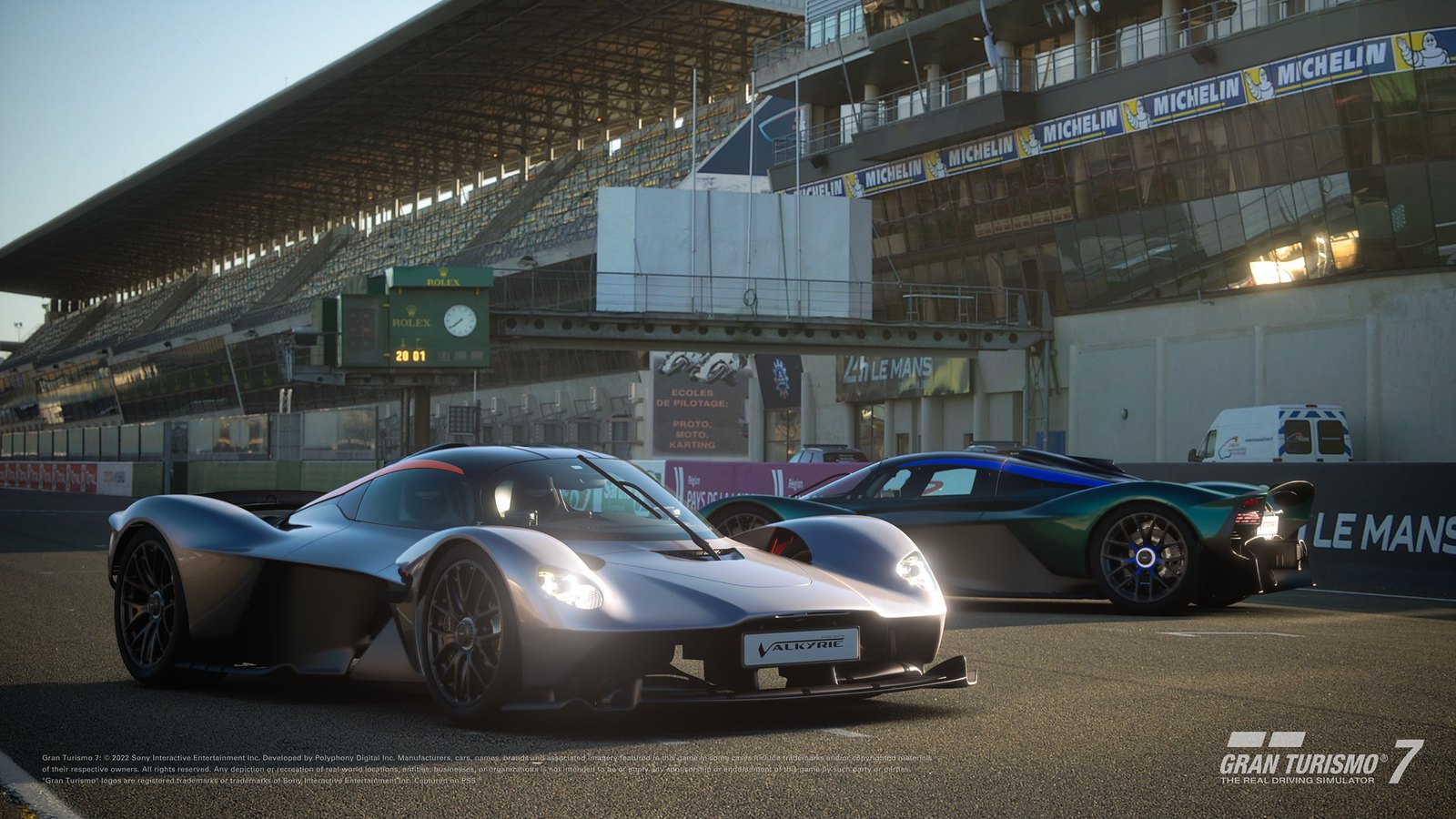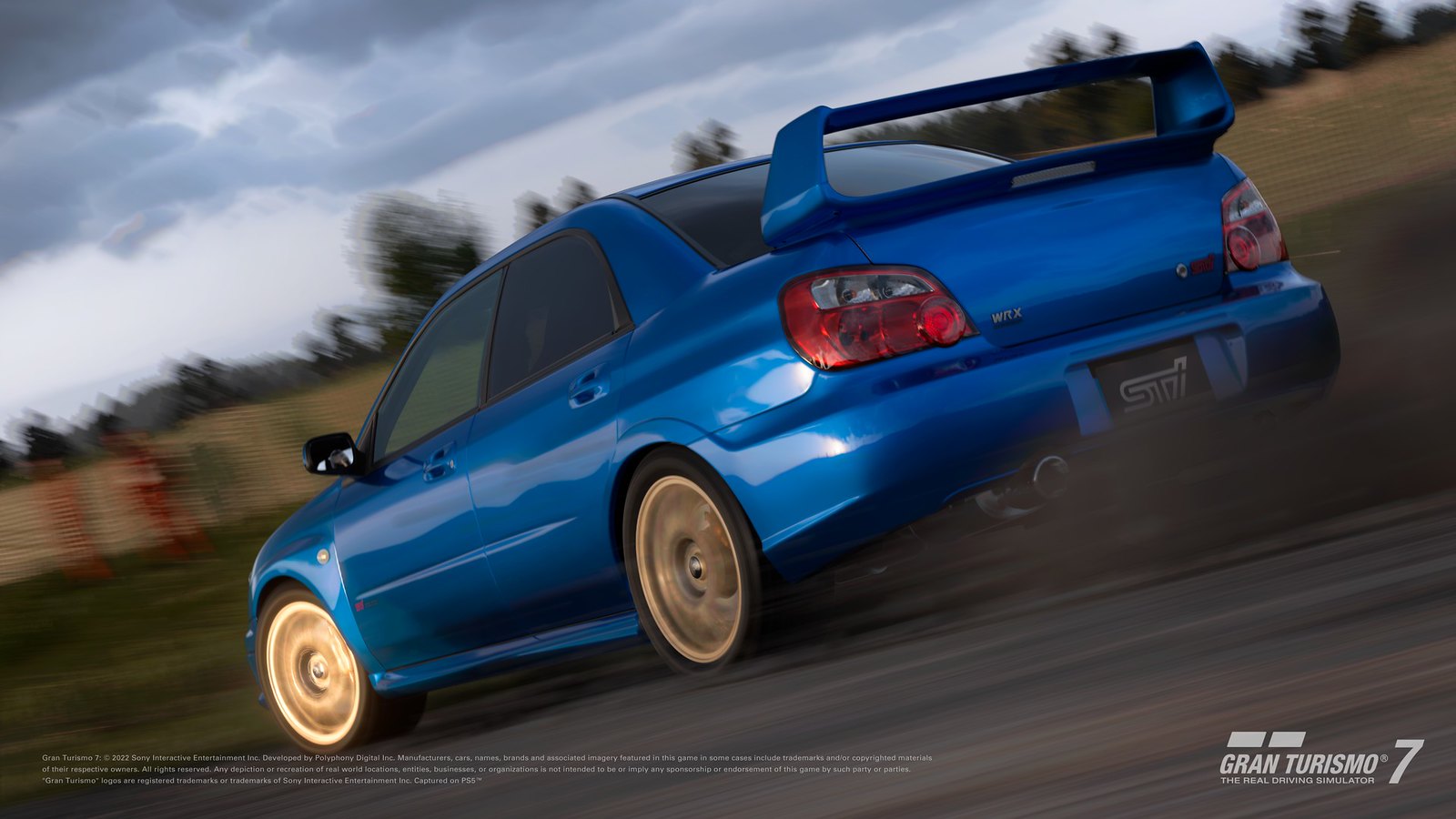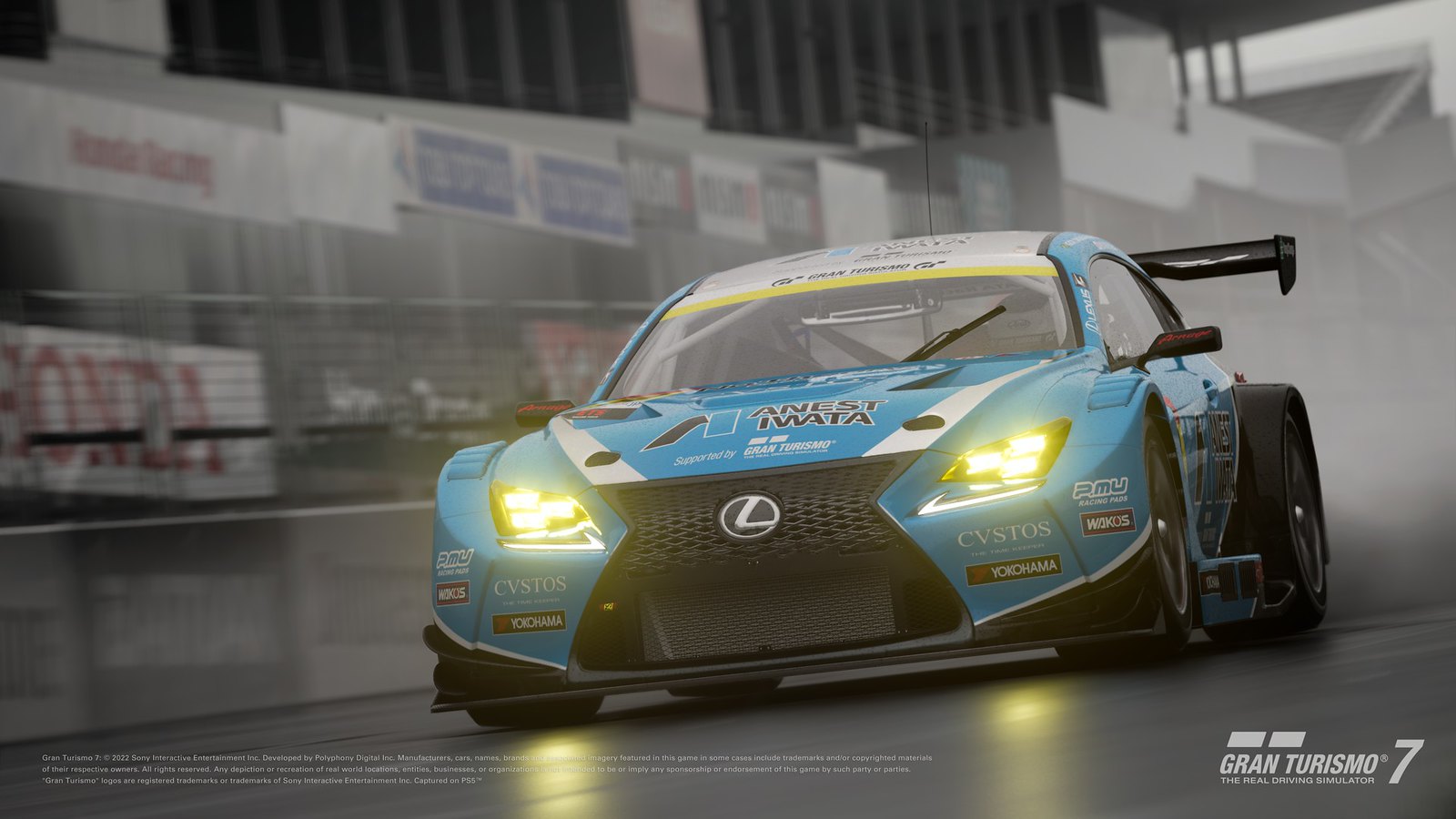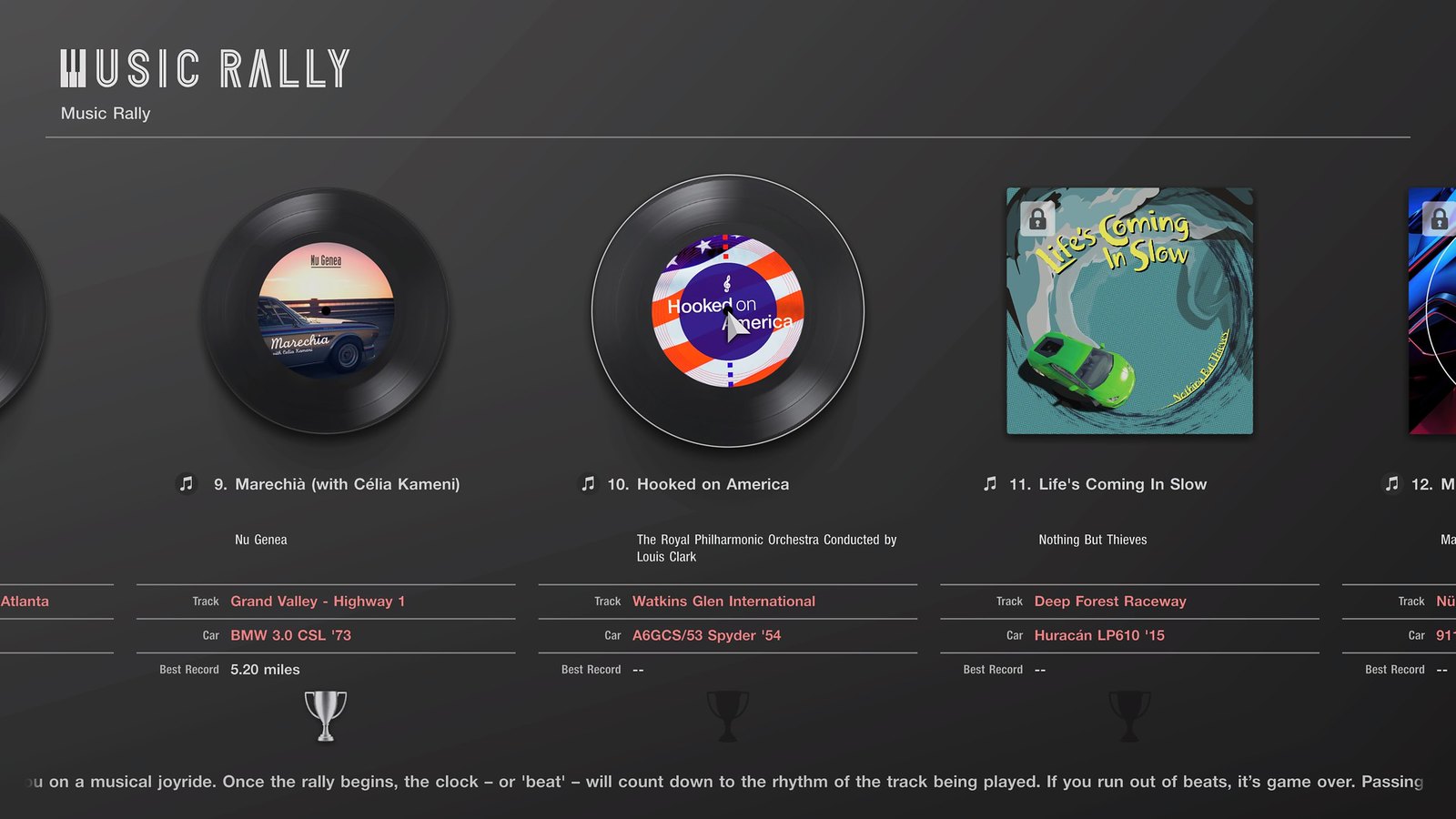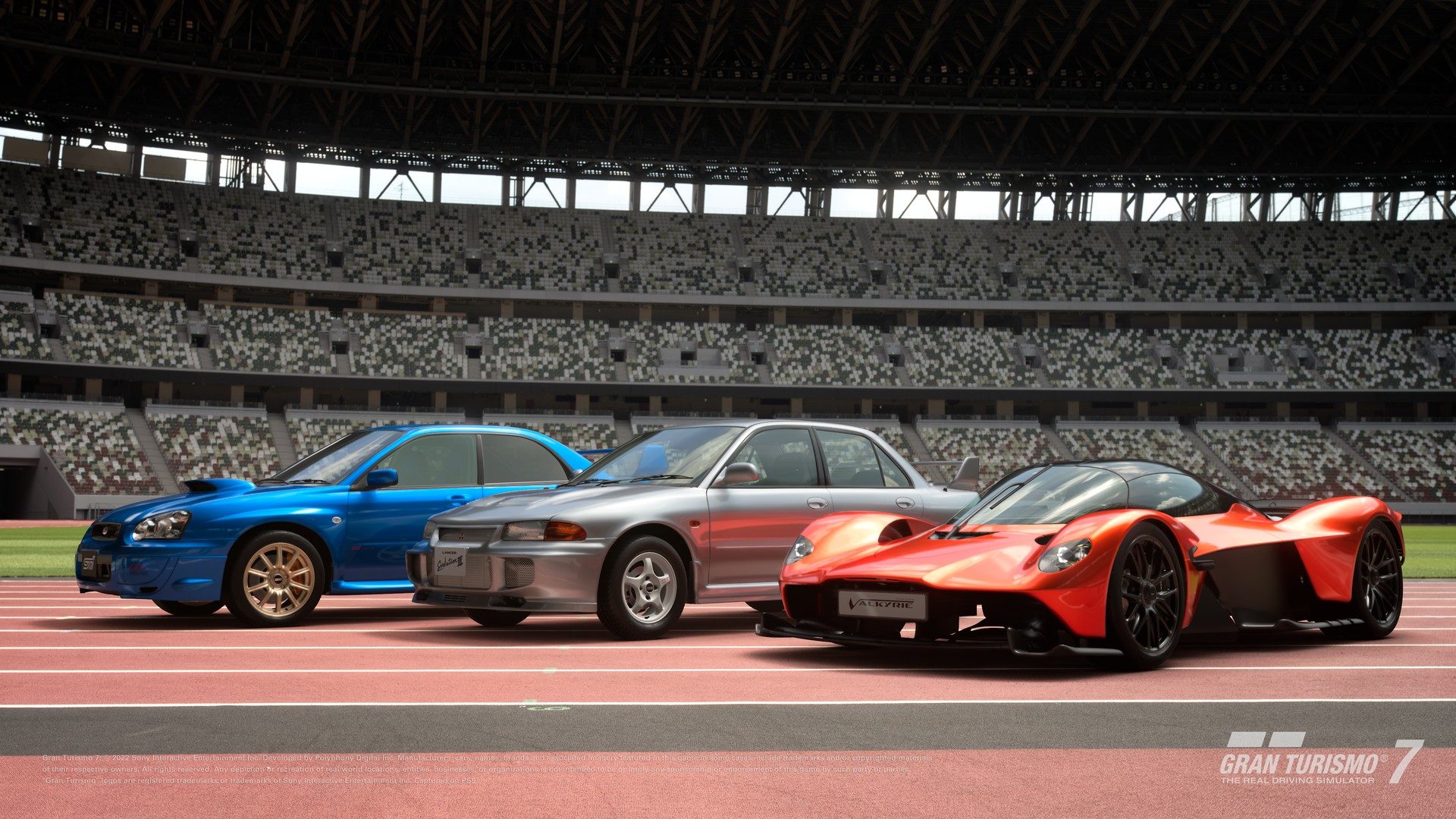
Gran Turismo players! The 1.35 update for Gran Turismo 7 arrives today June 28 at 11pm PDT* / June 29 at 7am BST / 3pm JST.

Introduction of 3 New Cars
Aston Martin Valkyrie ’21
A uniquely shaped hypercar with F1 derived aerodynamics.
Aston Martin is one of Britain’s most beloved luxury sports car manufacturers. This hyper car, the Valkyrie, is a result of their near 110 years of experience in the field combined with the expertise of F1 constructor Red Bull Racing. The design started from an idea for an innovative road car devised by Red Bull Racing’s designer and aerodynamics expert Adrian Newey. Newey took his proposal to Aston Martin where he made a connection with their chief designer Marek Reichman. In 2016, the project began in earnest as ‘AM-RB 001’. The car developed under the AM-RB 001 codename was first unveiled at the 2017 Geneva Motor Show, along with its official name, the Valkyrie.
Production versions of the Valkyrie were first seen in 2021, taking form as a uniquely shaped hyper car which incorporated F1 derived aerodynamics with the Aston Martin design language. The high nose of the car is equipped with an underslung wing and creates powerful downforce through the Venturi tunnels running under the body. Between them sits the teardrop shaped cockpit where the driver and passenger sit feet-up in the style of a formula car. Extensive lightening has been implemented across the carbon-fiber body with even the Aston Martin nose emblem being reduced to a 70-micron thick piece of aluminum. As a result, the car weighs roughly 1,000 kg, achieving an astonishing power-to-weight ratio of 1.01 kg/BHP.
Hard mounted to the rear of the cabin is the hybrid power unit, a Cosworth 6.5L naturally aspirated V12 engine with KERS (kinetic energy recovery system). The total output of the system is 1,140 BHP putting the car on par with even top category racing machines. The Valkyrie was first available in a limited run of 150 coupe models, which sold out almost immediately despite the price tag of over 2M pounds. The coupe was followed by the ‘AMR pro’ Le Mans style competition model and an open-top ‘Spider’ model. This pinnacle of performance is notable as one of the first hyper cars to reach the level of an LMP1 machine.
Mitsubishi Lancer Evolution III GSR ’95
Improved aerodynamics and cooling make for the ultimate first wave ‘Evo’.
The Lancer Evolution was launched in September 1992. Starting with the compact body of the commercial Lancer saloon and adding Mitsubishi’s mechanisms used only for the WRC-grade Galant VR-4, the Lancer Evolution became a rally-oriented car. At the core of this car was the 4G63, a turbocharged 2.0 L DOHC inline-4 engine, already producing 246.5 BHP and 31.5 kgfm of torque at the time of its debut. With overwhelming traction and power delivered to all four wheels, it was already much faster than any other model in its class.
One year after its creation, in December 1993, the improved Lancer Evolution II was revealed, with its maximum power output increased to 256.4 BHP. The tyres were also changed to 205/60R15, and modifications to the wheelbase and the tread size were also implemented. Around this time, it started to be called by its famous nickname, “Lan-Evo”, by the Japanese fans. Another evolution happened in January 1995.
The 3rd generation, called Lancer Evolution III, saw its exterior drastically modified to improve aerodynamic performance. With a larger opening in the front bumper and a larger rear spoiler, it now had the powerful look of a vehicle focused on competition. The compression ratio of the 4G63 power unit was raised to 9.0, improving maximum power output to 266.3 BHP. Detailed changes and enhancements were also made to the suspension, and these changes greatly improved both engine performance and maneuverability. At the time, the base Lancer model was about to receive a full model change, and it was rumored then that the Evo III may in fact be the last Evo.
Subaru Impreza Sedan WRX STi ’04
2nd generation Impreza which was developed alongside the rally spec model.
Just one year after the release of the radical Spec C, in November 2002, a facelift was already being implemented in the Impreza series. Though loved by many, the previous round headlights proved to be unpopular on the mass market and were abandoned in favor of imposing new teardrop-shaped lights. This time, under joint development with the SWRT (Subaru World Rally Team), new expertise facilitated the creation of better aerodynamic characteristics. On the performance side, a twin-scroll turbo system was introduced for better spool efficiency along with a modified exhaust system to match. The crankshaft, along with the pistons and conrods were reinforced enabling the engine to produce 40.2 kgfm, the highest torque figure in the 2-litre class at the time.
Some manual transmission models were also equipped with a driver-controlled center differential featuring an automatic mode. Depending on the conditions while cornering, the distribution of torque to the front and rear of the central differential was divided automatically, and the car demonstrated tremendous effectiveness on both circuits and winding roads. In June 2004, a model with larger tires was introduced. This was in response to demands from the motorsport field, such as in the Super Taikyu Endurance racing. The maximum torque was also increased to 42.0 kgfm at this time. The Impreza found its way to fame as one of Japan’s most representative high-performance cars, recognized by enthusiasts the world over. From 2003, the exportation of the STi model to America began, and with the Mitsubishi Lancer Evolution also starting exportation, the fierce rivalry reached further outside Japan’s borders.
Car Livery
The livery for the ‘Anest Iwata Racing RC F GT3’, driven by Igor Omura Fraga in the Super GT, has been added. This livery can be selected when purchasing the Lexus RC F GT3 ’17 in Brand Central.
GT Café Extra Menus
The following two Extra Menus have been added:
- Extra Menu No. 24: ‘Subaru WRX’ (Collector Level 26 and above)
- Extra Menu No. 25: ‘Mitsubishi Lancer Evolution’ (Collector Level 30 and above)
Music Rally
The following six events have been added:
- Good Old Days (Classixx Remix)
- DRIFT
- Marechià (With Célia Kameni)
- Hooked on America
- Life’s Coming in Slow
- Moon Over the Castle GT7 version
Two new Scapes
‘Monterey and ‘Field of Flowers’ have been added to the featured section.
Enjoy update 1.35 and happy driving!
*Internet connection and Gran Turismo 7 game required for update
Gran Turismo players! The 1.35 update for Gran Turismo 7 arrives today June 28 at 11pm PDT* / June 29 at 7am BST / 3pm JST.

Introduction of 3 New Cars
Aston Martin Valkyrie ’21
A uniquely shaped hypercar with F1 derived aerodynamics.
Aston Martin is one of Britain’s most beloved luxury sports car manufacturers. This hyper car, the Valkyrie, is a result of their near 110 years of experience in the field combined with the expertise of F1 constructor Red Bull Racing. The design started from an idea for an innovative road car devised by Red Bull Racing’s designer and aerodynamics expert Adrian Newey. Newey took his proposal to Aston Martin where he made a connection with their chief designer Marek Reichman. In 2016, the project began in earnest as ‘AM-RB 001’. The car developed under the AM-RB 001 codename was first unveiled at the 2017 Geneva Motor Show, along with its official name, the Valkyrie.
Production versions of the Valkyrie were first seen in 2021, taking form as a uniquely shaped hyper car which incorporated F1 derived aerodynamics with the Aston Martin design language. The high nose of the car is equipped with an underslung wing and creates powerful downforce through the Venturi tunnels running under the body. Between them sits the teardrop shaped cockpit where the driver and passenger sit feet-up in the style of a formula car. Extensive lightening has been implemented across the carbon-fiber body with even the Aston Martin nose emblem being reduced to a 70-micron thick piece of aluminum. As a result, the car weighs roughly 1,000 kg, achieving an astonishing power-to-weight ratio of 1.01 kg/BHP.
Hard mounted to the rear of the cabin is the hybrid power unit, a Cosworth 6.5L naturally aspirated V12 engine with KERS (kinetic energy recovery system). The total output of the system is 1,140 BHP putting the car on par with even top category racing machines. The Valkyrie was first available in a limited run of 150 coupe models, which sold out almost immediately despite the price tag of over 2M pounds. The coupe was followed by the ‘AMR pro’ Le Mans style competition model and an open-top ‘Spider’ model. This pinnacle of performance is notable as one of the first hyper cars to reach the level of an LMP1 machine.
Mitsubishi Lancer Evolution III GSR ’95
Improved aerodynamics and cooling make for the ultimate first wave ‘Evo’.
The Lancer Evolution was launched in September 1992. Starting with the compact body of the commercial Lancer saloon and adding Mitsubishi’s mechanisms used only for the WRC-grade Galant VR-4, the Lancer Evolution became a rally-oriented car. At the core of this car was the 4G63, a turbocharged 2.0 L DOHC inline-4 engine, already producing 246.5 BHP and 31.5 kgfm of torque at the time of its debut. With overwhelming traction and power delivered to all four wheels, it was already much faster than any other model in its class.
One year after its creation, in December 1993, the improved Lancer Evolution II was revealed, with its maximum power output increased to 256.4 BHP. The tyres were also changed to 205/60R15, and modifications to the wheelbase and the tread size were also implemented. Around this time, it started to be called by its famous nickname, “Lan-Evo”, by the Japanese fans. Another evolution happened in January 1995.
The 3rd generation, called Lancer Evolution III, saw its exterior drastically modified to improve aerodynamic performance. With a larger opening in the front bumper and a larger rear spoiler, it now had the powerful look of a vehicle focused on competition. The compression ratio of the 4G63 power unit was raised to 9.0, improving maximum power output to 266.3 BHP. Detailed changes and enhancements were also made to the suspension, and these changes greatly improved both engine performance and maneuverability. At the time, the base Lancer model was about to receive a full model change, and it was rumored then that the Evo III may in fact be the last Evo.
Subaru Impreza Sedan WRX STi ’04
2nd generation Impreza which was developed alongside the rally spec model.
Just one year after the release of the radical Spec C, in November 2002, a facelift was already being implemented in the Impreza series. Though loved by many, the previous round headlights proved to be unpopular on the mass market and were abandoned in favor of imposing new teardrop-shaped lights. This time, under joint development with the SWRT (Subaru World Rally Team), new expertise facilitated the creation of better aerodynamic characteristics. On the performance side, a twin-scroll turbo system was introduced for better spool efficiency along with a modified exhaust system to match. The crankshaft, along with the pistons and conrods were reinforced enabling the engine to produce 40.2 kgfm, the highest torque figure in the 2-litre class at the time.
Some manual transmission models were also equipped with a driver-controlled center differential featuring an automatic mode. Depending on the conditions while cornering, the distribution of torque to the front and rear of the central differential was divided automatically, and the car demonstrated tremendous effectiveness on both circuits and winding roads. In June 2004, a model with larger tires was introduced. This was in response to demands from the motorsport field, such as in the Super Taikyu Endurance racing. The maximum torque was also increased to 42.0 kgfm at this time. The Impreza found its way to fame as one of Japan’s most representative high-performance cars, recognized by enthusiasts the world over. From 2003, the exportation of the STi model to America began, and with the Mitsubishi Lancer Evolution also starting exportation, the fierce rivalry reached further outside Japan’s borders.
Car Livery
The livery for the ‘Anest Iwata Racing RC F GT3’, driven by Igor Omura Fraga in the Super GT, has been added. This livery can be selected when purchasing the Lexus RC F GT3 ’17 in Brand Central.
GT Café Extra Menus
The following two Extra Menus have been added:
- Extra Menu No. 24: ‘Subaru WRX’ (Collector Level 26 and above)
- Extra Menu No. 25: ‘Mitsubishi Lancer Evolution’ (Collector Level 30 and above)
Music Rally
The following six events have been added:
- Good Old Days (Classixx Remix)
- DRIFT
- Marechià (With Célia Kameni)
- Hooked on America
- Life’s Coming in Slow
- Moon Over the Castle GT7 version
Two new Scapes
‘Monterey and ‘Field of Flowers’ have been added to the featured section.
Enjoy update 1.35 and happy driving!
*Internet connection and Gran Turismo 7 game required for update

